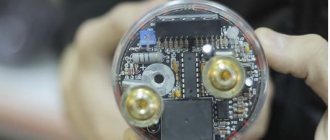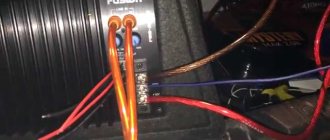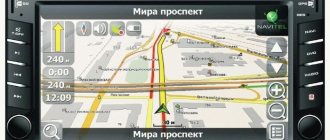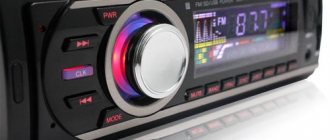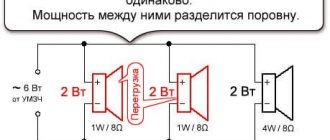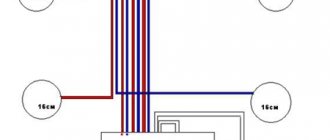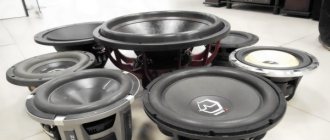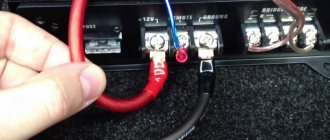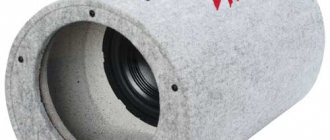The presence of a subwoofer can significantly improve the performance of a car's sound system, but this will only be possible if it is properly connected to an amplifier. Unfortunately, this operation is not as simple as many people think. In order for everything to work correctly, it is necessary to take into account a number of quite important parameters. In this article we will try to figure out how to properly connect a subwoofer to an amplifier.
Before you start connecting the active and passive subwoofer to the amplifier, it makes sense to compare the RMS values (the power at which the equipment can operate with a real sound signal for an hour without damage) of the subwoofer and amplifier. You need to select equipment in such a way that this parameter of the amplifier is higher than that of the subwoofer. Otherwise, you may exceed the permissible power level (clip), which is one of the most common types of speaker failure.
For optimal operation, the power of the amplifier and subwoofer should be approximately equal.
- How to connect a subwoofer to a single channel amplifier
What is an amplifier for?
The sound quality will depend on how well the connection is made. There are various options for installing a stereo sound or audio system in a car. So:
- If you are not satisfied with the power of your car radio (see Compare car radios and choose the best) or the quality of the sound it produces, you can solve this issue with the help of an amplifier. Of course, this is not at all the same equipment that is used in sound systems that operate on a 220-volt power supply.
- There is only one battery in a car, and two in a truck or bus - 12V each. Amplifiers for cars are designed for such a low-power network. How do they increase the existing voltage?
- The fact is that a voltage converter is built into the car amplifier. Depending on the technical characteristics of a particular device, the converter, using a pulse, can increase the voltage from 12 to 100 volts. So, the amplifier independently provides itself with the required voltage.
Amplifier selection criteria
Like any other equipment, a car radio has certain characteristics. Considering that it connects and works in the same system with other equipment, their indicators should be as close as possible to each other for joint operation. Therefore, before connecting the amplifier to the car radio, carefully study and compare the data:
- One of the most important technical characteristics of an amplifier is the unit of power per channel. So, when purchasing an amplifier, this indicator must be compared with the corresponding indicators of the rest of the equipment.
- You definitely need to know what the rated power of your rear speakers is, as well as the dynamics of the subwoofer (see How to make a subwoofer: practical tips). Their power ratings should slightly exceed the power of one amplifier channel. This will allow you to get the highest quality sound. In addition, such a distribution of power will prevent overloading of the speakers, and they will definitely not wheeze.
- Another important characteristic of an amplifier is load resistance. The load for the amplifier is the speaker system. Therefore, this characteristic should be equal for the speakers and the amplifier (for example: both there and there are 4 Ohms). It is quite normal if the load resistance of the speakers is slightly higher.
- But if it turns out to be the opposite, there is every chance that during operation both the amplifier and the speakers will fail. The frequency range in a car amplifier must be at least 20 Hz - 20 KHz. It would be good if this range were even greater.
Modern car amplifiers include an element called a crossover. It allows the amplifier to operate in different modes, as well as frequencies in different ranges. Sometimes they have a linear pass-through output, which allows you to connect another amplifier to it, if necessary.
Connection errors
An incorrectly installed audio system not only produces poor sound, but can lead to failure of the head unit, power surges in the on-board network, blown fuses, blown electrical appliances, short circuits and damage to the wiring.
List of common mistakes:
- An overpowered amplifier will damage the woofer. The main selection rule, which reveals the full sound potential of a subwoofer: the power of the amplifier should be less than the declared peak loads of the woofer. You can correctly calculate the amplifier rating using the formula: U – the voltage value of the vehicle’s on-board network with the engine running and powered by the generator = 14.4 Volts;
- I – nominal value of the fuse, or their total value in the case of several separate channels;
- Efficiency (efficiency factor) – constant value: class AB subwoofers – 50% (0.5), class D – 75% (0.75);
- n – number of independent channels of the device.
An amplifier with reduced power - the sensitivity range drops, the subwoofer cannot be “boosted,” and instead of a distinct bass, a background hum is heard. Incompatible radio and bass speaker parameters. If the head unit has a “Sub Out” pin, then the power is calculated using a similar formula as for an amplifier. The rating of the fuses in the system does not correspond to the peak load: if their value in Amperes is lower than necessary, then burnout will occur even at low powers. If the resistance is too strong, voltage surges in the on-board network and overheating of the electrical wiring occur. Incorrectly set polarity on the line outputs - the subwoofer does not turn on. Power and speaker cables do not correspond to network parameters - poor sound quality. Incorrect crossover or equalizer settings.
After installing the subwoofer into the speaker system, adjusting the low frequencies is carried out using a digital equalizer, bringing the speakers to peak loads. Modern devices have a wide range of capabilities and a range of different functions for adjustments (for example, bass boost adjustment, “Bass Boost”, noise reduction mode). Sound correction should be done carefully, not exceeding the signal level by 3 dB. It should be remembered that the increase in power to the woofer occurs multiple times: if you set the bass boost to +10 dB, then the power to the linear input register will be 14 times higher, resulting in overload, fuses blowing, and system components failing.
Which amplifier to choose if a subwoofer is installed
There are various modifications of these devices, and their selection depends on the configuration of a particular sound system:
- Let's say you have a subwoofer installed. In this case, you need a two-channel amplifier, and when purchasing it, you need to make sure that it can operate with a bridge connection method. By the way, the majority of amplifiers are like this.
Bridge connection of amplifier to subwoofer
- Bridging means that both amplifier channels drive the same subwoofer speaker. If a bridge connection for the amplifier is not provided, you need to think about how to connect the amplifier and subwoofer to the car radio, doing it so that the signal is summed.
- Car audio specialists often resort to certain tricks. You can make both channels work as one by summing the output signal. This connection is used when feeding a signal to a dual voice coil subwoofer.
- In this case, the channel outputs, with mandatory polarity, are connected to the subwoofer windings. Well, if it has a singular winding, special adders are used. As a result, a mono signal is obtained, the strength of which is equal to twice the power of one channel, minus losses during summation.
There is also a more complex option for connecting an amplifier to a subwoofer. Moreover, each channel of the amplifier has a separate acoustic system for which it works, and only then the signal is summed. The frequency ranges of the channels, in this case, should not overlap so as not to overload the amplifier. To do this, a passive filter is installed at its output.
Sound noise
Connecting the amplifier to the car radio should be done if, at high sound volumes, extraneous noise appears and the speakers wheeze. So:
- As a rule, this happens when they are directly connected to the amplifier built into the car radio. It has low power, and even if the manufacturer assures you. That it reaches, for example, forty watts, keep in mind that this is peak power, not audio.
- A multi-channel amplifier can correct the situation. And it’s even better if you connect 2 amplifiers - a car radio from almost any manufacturer provides for a similar sound circuit.
RCA connectors on the rear panel
- For connection, linear RCA outputs are provided on the rear panel of the radio, and there can be one, four, or even more. Although, in the simplest and most inexpensive versions of car radios, there may be no outputs at all.
- In this case, the amplifier is connected to the speakers (see How to choose speakers for a car radio on your own), but not directly, but through a special device that reduces the amplitude of the sound. It's called an attenuator. The cheap price of this device allows you to buy it at any radio electronics store. Although, you can use an old part, fortunately, the attenuator is built into every receiver and TV.
- Answer to the question: “How to connect 2 amplifiers to a car radio?” simplifies if there are still ways out. The easiest way is if there are two RCA outputs. They may be needed to separate the connection to the front and rear speakers.
Separating outputs using splitters
The front and rear outputs, in turn, can also be branched - and then you will need not two, but four connectors. If there is only one output on the amplifier, you have to use a special cord with the required number of branches. This cord is popularly called a “tulip”, you can see it in the photo above. But if you connect two amplifiers, you don’t have to separate the front and rear.
What you need to connect
How to connect an amplifier to a car radio, or rather, what wires do you need for this? This question is very important, and we will try to answer it in more detail. So:
- Let's look at the necessary set of wires that you may need during the connection process. The thickest one is the power wire. Its power is selected as follows: the power of all amplifier channels is summed up; if there are two of them, then, naturally, the power of the second is also taken into account.
- Let's say you plan to install two two-channel amplifiers: one of them has a channel power of 40 W, and the other has a power of 30 W each. In this case, the total power of all channels is: 40*2+30*2= 140 W.
- We add 30% for losses to this figure and we get 182 W. This is exactly the power that amplifiers will produce at maximum volume, and the cross-section of the supply wire must be selected based on this value. We divide the total power by the network voltage (182W/12V=15.17A), and we get the maximum current consumption.
Set of wires for connecting an amplifier
- The cross-section of a given wire is calculated for a certain current strength; there is a correspondence table for all cable products. If you tell the store consultant your number, they will immediately tell you which wire you need.
- In our case, for 15A a copper wire with a cross section of 0.75 mm2 is required. You can take a cable with a slightly larger cross-section. This will be a reserve in case of connecting more powerful audio equipment in the future.
- The sound supply from the car radio to the amplifier is carried out using an interconnect cable. The sound quality depends on it. And if you suddenly decide to save money by buying a thin cable with weak insulation and poor shielding, you won’t expect a pleasant experience from listening to music.
Interconnect or signal wire must have continuous shielding, strong insulation, a thick central core and a high-quality RCA connector. As for the length of any cable, it needs to be calculated so that it is enough to lay it around the cabin without tension.
- But the extra length is also not needed - one meter of reserve is enough. Take two copies of the interconnect cable of the same length. The second wire will be an additional wire that you will need during the connection process. We'll talk about this later.
Fuse holder
You will also need a fuse. Its power must be higher than the calculated voltage. In our case, this is 15A, which means that the fuse must be taken at least 20A. Well, you can buy any fuse holder flask based on your personal preferences.
List of required components
To begin with, let’s decide on a general list of parts, namely their name and function, and then give a recommendation for selection.
- Power wire. Supplies power from the battery to the amplifier. For a medium-sized sedan you will need 5 m of “plus” and 1 m of “minus”. You can get more accurate dimensions by measuring your car yourself.
- Bulb with fuse. An important component. Serves as protection in the event of a short circuit in the power cable.
- Terminals. Allows you to simplify the connection of power wires to the battery and car body. You will need 2 pcs. ring type. If the connection to the amplifier is on the blades, you will need 2 more pieces. fork type.
- Tulips and control wire. Transmits an audio signal from the radio to the amplifier. Can come complete with interconnect cables or be purchased separately.
- Speaker wire. Transfers an improved signal from the amplifier to the subwoofer. You will need 1-2 m. If you have an active subwoofer, this wire will not be needed.
- Additionally, a distributor may be needed if two amplifiers are installed.
Selection of cables and wires
The wires for the speaker system in the car are multi-core cables that transmit sound signals from the head unit or amplifier to the subwoofer. They play no less important role than the equipment itself. However, choosing the right option is not always easy. The cables presented in specialized stores differ in cross-section, core material, insulation and cost.
According to their purpose, cables for car audio come in 2 types:
- acoustic (such products are required to transmit a signal from the amplifier to the speakers);
- interconnect (they are needed to transport low-voltage signals from the radio to the amplifier).
The first piece of advice that professionals recommend following concerns the price category of the product. Thus, a cheap cable for connecting a subwoofer should not be purchased for expensive equipment, since the quality of the reproduced sound will deteriorate. At the same time, buying expensive wires for budget acoustics will be a waste of money.
Depending on the core material, wire sets come in several types:
- Copper. They, in turn, are divided into those made of rough copper and oxygen-free copper (OFC). In the first case, the products are basic and have a relatively low price. The base made of oxygen-free copper allows you to increase the conductivity of the cable, but the cost of the product will be an order of magnitude higher. Another copper wire is PCOCC, in which the base is made of pure copper.
- Copper-plated aluminum. This is another inexpensive wire option. Among the list of disadvantages of such a product, professionals name increased fragility and brittleness.
- Silver plated or silver. Such products for connecting a subwoofer to a receiver have high performance and durability, but are much more expensive.
What to choose - active subwoofer or passive?
To understand the need to use an active or passive subwoofer, you need to find out what the advantages of each option are. For example:
- A passive sub is a design made from a single block, with several speakers enclosed in it. To reproduce low-frequency sound, you must connect the subwoofer to an amplifier. The advantage of the passive option is its relatively low cost. The downside is the required additional space due to the need to connect connecting structures - an amplifier and a filter;
- An active subwoofer is a ready-to-connect acoustic unit with an amplifier and a frequency filter. The undoubted advantages of such a device are that it does not require additional space, it has a wide range of settings, and it is easy to connect to a standard car radio. But its cost is significantly higher.
As you can see, we have two equivalent options. Therefore, before installing a subwoofer, it makes sense to imagine exactly what we want to get in the end, how much money we plan to sacrifice and how the subwoofer can be placed in the car.
What you will need
How to connect a radio
To install a passive subwoofer without an amplifier on your own you will need:
- speaker cables required for switching;
- plastic buffers to hold the woofer housing in the luggage compartment of the car;
- plastic screwdriver for removing plastic interior trim;
- side cutters for cutting cables;
- plugs needed for connection;
- PVC tape or protective tube;
- flexible clamps;
- protective corrugated tube for laying cables.
Before starting installation work, you should make sure that the purchased equipment is compatible. Connecting speakers with inappropriate coil resistance causes the radio amplifier to overload, which damages the device. If the player has a security code, you need to make sure it is there. Otherwise, after connecting the battery to the on-board network, it will not be possible to restore the radio’s functionality.
How to calculate the required audio system power
A preliminary calculation of the power of the audio system will help you choose the right power cable and other necessary components. Here you will need to know the exact rated power of the installed amplifiers. The parameters can be found on the Internet for a specific amplifier model or in the instructions for the device. If a separate speaker amplifier is integrated, its power should also be taken into account.
The indicators should be added together, thus obtaining the power of the system. The power wire will need to be selected taking into account the obtained value. If a motorist plans to install higher-power speakers in the future, it is better to immediately select a cable with a reserve.
Methods for installing a subwoofer in a car
There are several ways to install a woofer. More often the subwoofer is installed in the trunk of a car. It is attached to the back of the seat or installed in the center of the trunk itself.
Speakers without enclosures can be built into a vehicle's interior trim, trunk floor, or enclosure specifically designed for a specific vehicle. This approach helps save a lot of free space.
There are compact subwoofers on the market that are installed under the front seats of a car. But more often such devices cannot boast of power.
How to connect a subwoofer to an amplifier?
In order to connect the subwoofer to the amplifier and car audio system, you will need the following tools:
- Pliers and wire cutters;
- Wires for connecting a subwoofer and amplifier - power and connecting cables, tulips;
- Plastic ties;
- Set of wrenches;
- Knife and insulating materials.
Since the wires will have to be pulled through the interior, in order to avoid chafing of the cable, it is better to use corrugated sleeves, which must be securely fastened to the cable connection points.
Subwoofer and amplifier connection diagram
As a rule, any type of device comes with an accessible diagram for connecting the subwoofer to an amplifier or car radio. For example, for a passive subwoofer:
Depending on the complexity of the model, installation will take from 1 to 3 hours of work.
How to connect a passive subwoofer to an amplifier?
Before installation, the terminals from the battery are removed to avoid short circuits. Afterwards, you should find a technological hole connecting the engine compartment and the interior. As a rule, it is closed with a plug, and on domestic cars it is completely absent. Then it will have to be drilled. If you plan to install the subwoofer in the luggage compartment, a hole is made there too. Since the cable will pass through the entire interior, you will have to remove the trim or door sills - everything is individual. Next, instructions:
- Connect power from the battery to the amplifier in the luggage compartment according to the polarity. The power wire should be inserted into the corrugated sleeve in advance - a hole should be drilled along its diameter. In addition, it must be equipped with a fuse;
- Next, the amplifier wire is connected to the radio. First, its body is dismantled, exposing the wire connections. For connection, tulips are used, which are inserted in accordance with the colors of the connectors;
- To achieve simultaneous activation of the radio and subwoofer, it is necessary to equip the amplifier with a positive wire, which is connected by a terminal to the power cable of the radio;
- The last stage is connecting the amplifier and the subwoofer itself. Before connecting a subwoofer to a two- or four-channel amplifier, you should organically arrange the power inside the trunk or interior and connect each speaker to the appropriate input.
A capacitor is required for an amplifier with a power of more than 400 W. For less powerful models, it may not be used. It is worth remembering that using very powerful amplifiers will quickly drain the battery.
By the way, if you are not satisfied with the models manufactured by foreign and domestic companies, you can make a passive subwoofer yourself.
How to connect an active subwoofer to an amplifier?
Considering the compactness of the system (built-in amplifier and subwoofer), the connection seems simple. However, it is not. Let's look at how to connect an active subwoofer to an amplifier:
- Installation begins by connecting the power wire to the battery directly with a bridge to the positive terminal. The cable cross-section must be large;
- The power cable connection circuit provides a fuse for emergency disconnection of the system from the battery in the event of a short circuit. Mandatory location of the fuse in the engine compartment, next to the battery;
- The negative cable of the amplifier is connected to the car at a convenient point. Thus, the “-” wire is located between the body ground and the subwoofer.
Separate active subwoofer connectors make installation simpler - just lay a coaxial cable and connect its ends to the output of the car radio and sound converter. On the device they are designated SubOut and Lineln, respectively.
Process and connection diagrams
In order to correctly navigate how to connect a subwoofer, it is worth understanding what type of equipment the purchased model should be classified as. They come in 2 variations: active and passive. When studying popular schemes for connecting subwoofers in cars with settings for a standard radio, you need to focus on such points as:
Are you a car driver?! Then you can take this simple test and find out. Go to test »
- the frame and amplifier (overall parts) should be located as compactly as possible, and you need to think in advance where to place them;
- take care of good cooling (during operation, powerful heating occurs, so the air must circulate freely);
- stop a short circuit (if there is no analogue for communication and control wires, then the program will need power from the battery).
The System Remote Control format is also required for control: without it, the connection diagram will not work. When the device a priori does not have this output, it is advised to route a continuous flow of volts directly to the beginning of the subwoofer.
What you need to connect
To effectively organize the connection of a capacitor in a subwoofer on your own at home, you should prepare the following set of tools:
- tongs (construction) and knife;
- wrench and adjustable wrench;
- electrical tape (or something similar for temporary fixation);
- pliers;
- wiring (battery, “tulips” and “+” wire);
- plastic ties and pullers;
- power and speaker cables;
- fuse (minimum 60A).
During installation, special attention should be paid to the selection of elements for feeding the subwoofer and cable for acoustics. This depends on the category of transport and the availability for subsequent installation of wiring directly under the decorative trim of the car dealership. The cross-section is closely intertwined with the power of the kit or amplifier: the current strength must match the power cable and not reach overheating.
Connecting a passive subwoofer
The algorithm according to which a passive subwoofer is connected looks like a special design that includes 1 or slightly more low-frequency speakers, a set of filters and an amplifier. They are combined into a single body, which is made of plywood or wood (dense base). If you want to connect a passive subwoofer to the receiver, you will have to spend about 1-3 hours, which depends on your personal skills and the condition of the car.
The procedure consists of the following steps:
- Before starting work on the battery, remove the terminals (which will automatically eliminate the possibility of a short circuit).
- You need to find the hole made, which is covered with a plug. On domestic transport it may not be observed, and you will have to additionally make a hole and seal the seal with sealant.
- To combine with a radio, you will need “tulips”, as well as a spare wire that allows you to control the power.
- “Tulips” are connected in accordance with the colors of the connectors. To connect the subwoofer and equipment in parallel, use the required “+” wire.
- The wiring under the hood should be placed in a standard harness and carefully brought into the cabin; Think in advance about how the power cable will be installed.
- Sometimes it will be necessary to temporarily remove the interior trim and sill trims to avoid pinching or kinking.
- After the final installation, all used parts are attached back to the body through the hole. And connecting a passive subwoofer with power is oriented towards polarity.
- You should find the location of the terminal and connect it to the power cable of the built-in radio.
All that remains is to configure the connection of the subwoofer to the receiver. When changing the settings of a two-channel amplifier to share power, all channels are connected to one device.
The capacitor does not need to be used at all: this part is only necessary when the amplifier has a maximum power above 400 W. But setting up a subwoofer in a direct connection will provoke a large consumption of energy, which will lead to rapid discharge.
Without amplifier
Sometimes it is necessary to activate a connected passive subwoofer directly to the equipment, without adjacent amplifying additions.
It is possible to set up a connection this way, but it is necessary that the entire frequency line goes to the dynamic head instead of low copies.
Then the signal to the subwoofer is dialed from any of the radio channels.
Direct connection to a monoblock - sometimes a central type amplifier can fail, since the resistance can be of different calibers, which leads to an overload of the output in the radio.
Connecting an active subwoofer
An active sub is a pre-prepared acoustic unit that includes not only a speaker and a filter, but also a device amplifier. It is much easier to connect such equipment, and the quality of the melody is superior to the passive analogue. Although, according to the act, the sound level depends on how well the connection is made. The most reliable way to set up an active subwoofer is a primitive sequence of steps:
- Disconnect the car and then remove the terminals from the battery.
- Lay the power cable to the subwoofer fixation point, while the cable itself should preferably not remain under the pedals or interfere with neighboring mechanisms.
- Leave the fuse close to the battery. There is no need to connect the power cable to the battery terminal.
- Remove the original radio and carefully inspect the rear panel to find the linear output for low frequencies and the control wire.
- To connect an active subwoofer to the radio, you should lay the acoustic elements and the REM wire under the casing and secure them firmly.
- The grounding must be taken from the metal surface of the car body, the twisting area must be isolated and the device must be installed in its normal location.
- Finally, it is worth connecting the power cable directly to the “+” terminal of the battery and ensuring a large cross-section.
When the active subwoofer radio is immediately supplemented with a special connector in the connection diagram, the switching will be much easier. Then it is enough to install a coaxial cable with a connector: on the first side the wire will connect to the SubOut output, and on the opposite side - to Lineln. Connecting an active subwoofer to the receiver features a built-in amplifier, which makes it possible to save space in the vehicle.
Without line output
Sometimes car enthusiasts find themselves in a situation where attempts to connect a subwoofer to a standard radio are met with a problem in the form of a lack of communication with a passive amplifier or an active program. But there is no need to replace equipment in a car without a linear output. You can configure the device through an alternative input, as a spare signal level converter. A high-level stream is taken from the adapter to the amplifier. Depending on the type available, the feed can be controlled if necessary (for the sake of disappearing distortion).
Connecting from a computer to a radio
When the standard supply of standard melody in a car is not satisfactory, and you need ways to quickly improve the sound, then a good solution is to try to connect a subwoofer directly from a computer.
The device can be configured in 2 ways: by supplying power via a 12/220W inverter or through any contacts (+12W) on the board.
A tester and minimal knowledge of radio electronics will help you connect it correctly. Having orientated yourself with the battery, you need to send an audio signal to the subwoofer, having previously arranged it from the straight-line output of the equipment using a screen cable of the requested length.
Through crossover
This replacement duplicates the filter, dividing frequencies into ranges and thereby improving the sound level in the car radio. They are not only active and passive, but also one- and two-way. Each drive option has its own advantages and disadvantages, as well as price.
It is worth paying attention to their location:
- passive ones are configured in front of the speakers, 1 piece is enough;
- active crossovers are placed opposite several amplifiers.
The speakers themselves need to be connected to the subwoofer with a separate channel wire. It is important to consider that if you do not use a frequency filter when connecting a subwoofer, the full range will be supplied - from low to high. And without separation, the sound will be worse.
Connecting two subwoofers
To connect two subwoofers, you need to connect their adjacent wires according to the standard principle: “+” connect to “+”, “-” to a similar “-”. It is necessary that the configured device be carefully matched to the relative technical characteristics of the other device. The pair connection can be:
- Consistent. So the car owner will receive a total resistance of 4 ohms, and a large proportion of AB format amplifiers are designed only for a fixed resistance. The total power of the speakers is summed up.
- Parallel. In a spare circuit, the final resistance size must be 1 ohm; this indicator is already considered critical for most AB type amplifiers, and for the neighboring class D it is the operating level.
In the process, everything depends on how to install the amplifier, where the 2 subwoofers in question will be connected in the future.
Laying wires
Fixing the power cables and supplying audio signals becomes the initial plank during the adjustments made. Before starting installation, you should decide on the initial location for setting up the amplifier: according to the standard rule, the cable should be laid under 300 mm (including the spare part), and the laying itself should be left under the interior trim. At the same time, the wire can be connected to the battery terminals or to the power cable of standard electrical wiring (as an additional option).
A protective fuse must be fixed in the circuit: the installation point must guarantee free access for careful examination or replacement. If, when trying to connect a capacitor, the gasket needs to be directed through the body partition, then it should be routed to non-standard channels. If they are missing, it is recommended to create holes protected with special plastic clips.
Subwoofer wires should not come into direct contact with sharp metal edges, be pinched by sheathing, or be located in areas susceptible to condensation damage.
Grounding
Correctly connecting the ground or negative power wire can be done in parallel with the positive wire setting. To install the cable in question, it is recommended to use special bolts that are in the car (on the body).
To achieve good contact performance, you need to thoroughly clean the metal from any signs of corrosion, paint residues and primer.
The edge of the wire must be supplemented with a special terminal, which is secured as tightly as possible with a nut.
Speakers for subwoofer
Before connecting your speakers and subwoofer to your amplifier, it is important to select your speakers. Owners have different tastes when it comes to car stereo systems. Loud music for a teenager who has just received his license will become tiresome for a lover of quiet sound. The subwoofer's subwoofer bass and front bass are enhanced or sounded quieter by different sized speakers. The suggested range is from 6 to 15 inches. What to choose:
- Speaker diameters up to 10 inches will not produce rich sound. They are suitable for a car enthusiast who is not ready to spend a lot of money and does not strive for loud and surround sound;
- Speakers from 10 to 15 inches are the golden mean, and provide rich sound at an affordable price;
- Speakers larger than 15 inches are used for car audio competitions. High volume and very powerful sound make them not the best option for a family car. It should also be noted that the volume allowed for car audio competitions often does not comply with current legislation, and such speakers cause installation problems due to their size.
We also recommend that you familiarize yourself with our rating of car subwoofers.
Car subwoofer: types and design features
A subwoofer (SBV) is an acoustic system that converts low-frequency sound waves.
You don't need it to listen to most music tracks. A sub is needed for high-quality sound of low frequencies (bass).
Subwoofers come in two types:
- Active - they already have a built-in power amplifier;
- Passive - there is no amplifier and requires additional connection so that the output sound is clear without distortion or interference.
A passive subwoofer may look like a regular large speaker or a box in which the speaker is placed.
Structurally, an active sub consists of the following elements:
- body - wooden or plastic;
- woofer;
- signal regulator;
- amplifier;
- signal frequency regulator.
For high-quality sound, the active sub must be correctly connected to the radio.
Types of subwoofers by design:
- Horn - the type has a folded horn-speaker, used at concerts;
- Closed - is a speaker installed inside and tightly adjacent to the walls of a closed box;
- Bass inverter - a type using a ventilation pipe, from which, under the force of sound waves, air comes out along with low-frequency sound;
- Quarter-wave resonator - acoustics with a tunnel design, a tunnel-pipe, of a given length and cross-sectional size through which sound comes out;
- Bendpass is a box with a bass inverter, divided in the middle by a wall into two chambers, different in volume, the speaker is placed in the partition between them.
How to set up a subwoofer in a car
Setting up the subwoofer should be done while designing the speaker box. The main role here is played by the parameters of the speaker, which determine the boundaries of its functioning in the acoustic design. If you have a dilemma about how to set up a sub in a bass reflex enclosure, it is recommended to install the port both higher and lower, depending on your favorite type of music. And for a device in a factory frame, connecting a subwoofer with a bridge is limited, but with a well-chosen circuit it is more than possible to achieve good sound.
As a backup option, use special applications for your phone (Subwoofer Bass).
Setting up the LPF lowpassfilter filter
Nowadays, a classic LPF filter is almost always present on a subwoofer. This type of filter allows you to select the threshold at which high frequencies begin to be blocked, which allows you to simply mix the signal with other speakers. To properly configure the filter, you need to know in advance how this is done.
First, you need to make sure that the initial parameter was not too high, and that the woofers on the subwoofer do not overlap: this risks leading to unnecessary emphasis on one frequency level (about 120 Hz) and unclear sounding of the acoustics. But if connected too low, there may be a large gap between the car signal and the speakers.
At the start, it is recommended to set the LPF filter at a frequency of 80 Hz, and then conduct a sound test and change it as desired until it sounds as the owner requires. It’s better to deactivate the filter on the radio. When there is a chance to apply LPF on the main device, you need to activate it only there. You should not run the filter at the same time as the amplifier.
Setting up a subsonic
Subsonic is an infrasonic format filter that can block ultra-low frequencies that always appear in some compositions. These frequencies cannot be heard at a typical threshold because they operate below the threshold of human hearing. But when they are not initially trimmed, the device will consume additional energy through startup relative to the all-in-one.
You can set up an active subwoofer in your car, automatically blocking infra-low frequencies - the device will be able to effectively reproduce only those that are present within the established limits. Thus, unpredictable failure of a two-coil subwoofer after accelerated movement of the diffuser is eliminated.
The speaker will try to repeat frequencies that lie outside the perceptible range (20-25 Hz and below). Then the diffuser will speed up, which risks causing the two-coil device to exit near the gap and result in damage. Subsequently, the quality of reproduction of the required bass range increases in quality, in addition, the volume increases.
To tune the subsonic, you should set it at least 5 Hz below the level of the bass reflex port. To do this, turn on the switch and move it to the desired data. When the subwoofer is configured correctly, passengers in the car will not hear it, since it should not provoke interference with the central signal.
Setting the input sensitivity GAIN
Sometimes car owners do not know how to correctly adjust the input sensitivity. This value demonstrates how it is possible to apply a signal to the input in order to result in rated power. It should be adjusted for the incoming flow voltage. It is worth adjusting the input sensitivity correctly to prevent accidental signal changes, distorted sound, or other problems with the speakers.
To change the GAIN values, you will need:
- digital voltmeter, which can measure AC voltage values;
- test CD or file where a sine wave is saved with an initial level of 0 decibels (it is important not to use a weak test signal);
- instructions for the subwoofer for the car, which mentions the permissible output voltage.
You must disconnect the speaker wires from the unit and ensure that the bass, equalizers, and other settings on the head unit are turned off to get clear sound. The level of input sensitivity should be minimal, so it is better to switch to bridge mode. You can use an oscilloscope to collect more accurate data.
Acoustic phase
Many subwoofers are equipped with a “Phase” switch on the rear panel, which should be fixed at the 0 or 180° position. If you set the power switch to one side, the 2 conductors will transmit the music signal to the rest of the electronics in the same direction. You just need to flip the switch and, carefully adjusting the reception, change the position. Then the shape of the sound will be reversed. When you cannot use such an amplifier, you can swap the “+” and “-” wires on the speaker.
Setting up or how to make a case
How to properly set up an active subwoofer in a car
In order for a subwoofer speaker to function normally, it is necessary to make a high-quality housing for it. Its further sound depends on the quality of the subwoofer box:
- If the displacement of the box is incorrect, the speaker will not play. It will make sounds similar to wheezing.
- With a flimsy subwoofer box, it will be impossible to achieve clear bass. On the contrary, it will always be difficult to hear.
- It is necessary that the housing has the correct shape, otherwise “standing waves” may form inside it, affecting the sound quality.
Some of the best cases are those that are made to order. The manufacturer needs to provide the dimensions of the speaker or itself. Due to this, all the subtleties and nuances of the device will be taken into account, so the sound will not be primitive.
How to set up a subwoofer yourself
Active subwoofer how to set up
acoustic system Therefore, now we will discuss how you can set up a subwoofer yourself:
You must purchase a special disk. It will allow you to identify shortcomings of the entire speaker system, including the subwoofer itself. A special melody is recorded on this disc, which allows you to hear even minimal defects.
Special disk for setup
- It is necessary to adjust the active subwoofer until the sound of this disc is ideal for the user.
- What exactly is a setting? This is a sequential switching of three buttons: Bass, Tribble, Sub.
As you can see, installing a subwoofer and setting it up in a car can be done easily with your own hands. It should be borne in mind that such a process is impossible without primary preparation. So, initially you should look at photos with a similar theme. Perhaps you will find some instructions on the Internet that will also not be superfluous. A video on this topic will also come in handy. The price of installation and configuration in a car service can vary: installation of an active subwoofer starts from 3,500 rubles.
Subwoofer line connection
Sometimes a stereo ULF is used for a low-frequency system. Often household appliances are updated and the old low-frequency unit is used to connect the speaker system. In this case, to properly connect the subwoofer, you need to assemble a simple circuit, which is a voltage divider and a channel mixer. The signal is taken directly from the amplifier's outputs, so its output voltage must be limited.
To connect the wires to the subwoofer, a well-insulated speaker cable is used. This method is also used if the standard car radio does not have an audio output for connecting external speakers. You can make a linear converter yourself or purchase a finished product. When using a ready-made converter, you do not need to connect the wires to the adapter. It is better to install the converter in close proximity to the radio.
Assembly and connection
There are several types of subwoofers, and each of them can be assembled with your own hands, installed yourself, or, of course, you can buy a ready-made one. There is nothing complicated in self-assembly and you can ultimately achieve good results by solving an interesting problem and using extra parts lying around. It is much easier, of course, to buy a ready-made one and connect it without outside help. Connecting yourself will help you save a significant amount. Connecting a subwoofer carries the risk of damaging the interior trim. The car may be damaged. There are no more risks. The wires must be hidden. In general, wires come in different colors, but in any case they will be noticeable.
Determining the power of the audio system in a car
Calculating the power of the audio system will allow you to choose the right power cable. To do this, you need to know the rated power of all amplifiers installed in the car. You can look it up in the instructions or find it by the name of the active subwoofer or amplifier on the Internet.
If, in addition to the subwoofer, an amplifier is also installed on the speakers, the power of all amplifiers should be summed up.
For example, your car has 2 amplifiers. The first is for a subwoofer with a power of 300 W, the second is a 4-channel with a channel power of 100 W, installed on speakers. We calculate the total power of the audio system: 4 x 100 W = 400 W + subwoofer 300 W. The result is 700 W.
It is for this power that we will select the power wire; if in the future your audio system is replaced with more powerful components, we advise you to choose wires with a reserve.
A set of cables for a subwoofer, a budget option for weak systems
A common option is to purchase a ready-made set of wires. This solution has its advantages. Firstly, such kits are inexpensive. Secondly, the box contains everything you need to connect.
There is one minus. These kits use aluminum wires coated with copper. They have high resistance, which affects throughput. Depending on conditions, they oxidize and rot over time. This option is suitable for those who have a modest budget and low system power, for example, for connecting an active subwoofer.
Four main types
The main types of subwoofers are:
- open;
- hull;
- active;
- passive.
An open subwoofer is the first option. It needs to be built into any of the car panels. This is a smart option for anyone who doesn't like to fiddle around for too long. There is a second option - case-based. It will have to be built into a special box. The calculation here must be accurate. This box increases the sound pressure on the speaker. The speakers are 100% engaged. With its help you can slightly adjust the sound.
There is also a distinction between passive and active. Passive is simple. It lacks an amplifier and crossover. It must be connected in parallel with other speakers. You can make a crossover yourself and include it in the system. But it’s easier to immediately install an active subwoofer, which has both an amplifier and a crossover. Connecting an active subwoofer to your car will solve many problems at once.
In addition, a passive subwoofer sometimes causes a quieter sound from the speaker system, which must be taken into account when making a decision. Active will give good volume. An amplifier and crossover simplify the wiring diagram. It is easier to install an active subwoofer with your own hands without experience, although some may disagree with this point of view.
The amplifier and crossover are important elements. Think about the available options, compare them with the final goal, which is drawn in the mind - rationally. If there is no time or desire to choose or think, in the worst case, an extra part may appear in stock, which is also not a disaster. The supplier or seller, alas, is not obliged to accept back the purchased item if there is no receipt, damage appears, and so on. The money spent could have been invested in something else, but you can always sell speakers, microphones, subwoofers to someone who really needs them. This will allow you to return most of the amount.
